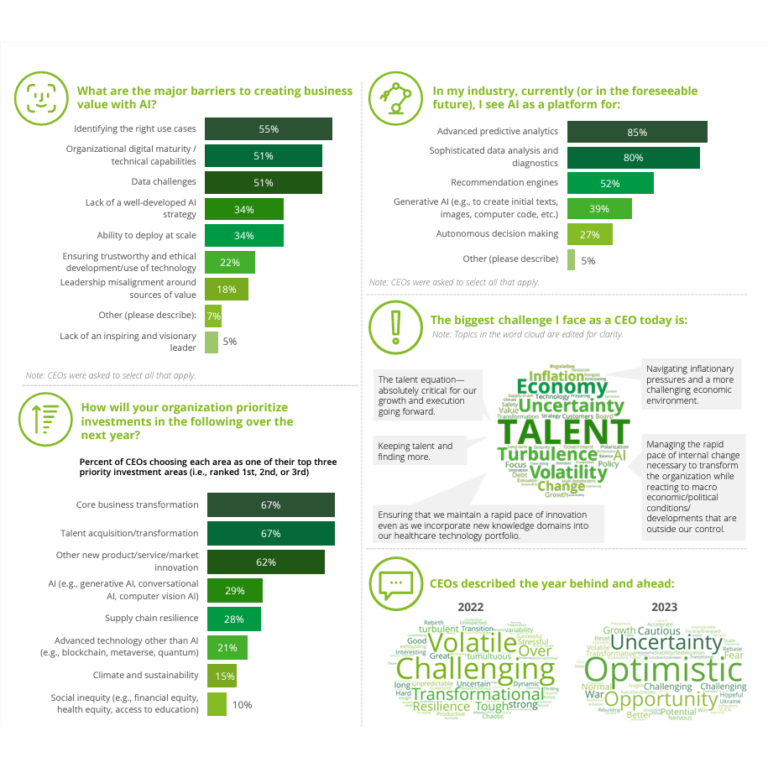This 5th and final blog in our series delves into the strategic steps to integrate Process Automation and AI into your business operations. Throughout this journey, we’ve explored the confluence of recent technological advancements and economic challenges, highlighting how automation and AI serve as pivotal forces for business transformation in an ever-changing landscape. From discussing the unique scenario businesses face due to global economic fluctuations, to showcasing how process automation and AI-driven processes can be catalysts for transformation, to presenting real-world use cases of business innovation through AI-enhanced automation, and outlining strategies for business leaders to leverage these technologies for enhanced cash flow, profitability, and growth—our series has aimed to equip business leaders with the knowledge and insights needed to navigate these complex times.
As we progress through 2024, the business environment continues its rapid evolution, driven by technological breakthroughs. Business leaders are tasked with a clear imperative: to adapt swiftly and strategically to maintain a competitive edge. The integration of Process Automation and Artificial Intelligence (AI) into your operational framework is not merely a fleeting trend, but a foundational shift necessary for enhancing operational efficiency, staying competitive, and achieving growth in today’s dynamic market landscape.
The Imperative of Process Automation and AI
Recent research underscores that businesses adopting AI and automation can see up to a 40% boost in operational efficiency. This is not about mere cost-saving measures; it’s about reallocating vital resources to maximize value creation. For businesses, especially mid-sized companies where every resource counts, these efficiencies can be transformative, propelling scalability and improving market stance. It is no surprise that ‘Core Business Transformation’ is one of the top 3 priority investment areas for 67% of the CEOs this year [4].
Strategic Integration Steps
1. Assess and Identify Key Areas for Automation
A staggering 55% of CEOs see identifying the right use cases as a major barrier to creating business value with technology, particularly AI [4]. This highlights the importance of the first step—conducting a thorough audit of existing processes.
Begin with a comprehensive audit of your existing processes to find inefficiencies and bottlenecks. This step involves mapping out all business processes and identifying tasks that are repetitive, time-consuming, and prone to human error. Tools like process mining can be instrumental here, offering insights into process performance and pinpointing areas where automation could bring significant improvements. The goal is to create a prioritized list of processes based on factors such as potential ROI, impact on customer satisfaction, and ease of automation.
2. Prioritize Based on Impact
After identifying potential automation candidates, evaluate which processes, when automated, would yield the greatest benefit to your bottom line and customer satisfaction. This involves a cost-benefit analysis considering both direct and indirect impacts of automation, such as increased speed, reduced error rates, and the potential for 24/7 operation. Prioritize processes that align with your strategic goals, such as improving customer experience or enhancing operational efficiency. This step ensures that your investment in automation and AI delivers the most value, reinforcing your company’s strategic objectives and competitive advantage.
3. Cultivate a Culture of Innovation
The concern over organizational digital maturity and technical capabilities, as noted by 51% of CEOs, underscores the need for Cultivating a Culture of Innovation [4].
Adopting new technologies requires more than just implementing new tools; it necessitates a shift in corporate culture towards embracing innovation and continuous improvement. This involves training and educating your workforce about the benefits of AI and automation, addressing fears about job displacement by highlighting the role of technology in augmenting human work, and fostering an environment that encourages experimentation and learning. Leadership should champion this cultural shift, demonstrating a commitment to leveraging technology for growth and efficiency. Engaging employees in the transformation process helps in identifying new opportunities for automation and innovation.
4. Partner with the Right Providers
Selecting the right technology partners is crucial for the successful implementation of AI and automation solutions. Look for providers with a strong track record in your industry and who understand the unique challenges and opportunities your business faces. A good partner should offer scalable solutions that can grow with your business, provide robust support and training, and have a clear roadmap for future developments. Collaborative relationships with technology providers enable you to customize solutions that fit your specific needs, ensuring that the technology integration adds the most value to your operations.
The lack of a well-developed AI strategy and the ability to deploy at scale, each cited by 34% of CEOs as barriers, reinforces the need to select and partner with the right partners [4].
5. Measure, Iterate, and Scale
Finally, implementing AI and automation is an ongoing journey that requires continuous measurement, iteration, and scaling. Establish clear KPIs to measure the performance of automated processes and the impact of AI applications on your business. Use these metrics to refine your approach, adjusting based on performance data and feedback from users and customers. As you identify what works, look for opportunities to scale successful implementations to other areas of your business, leveraging the learnings from initial projects to drive broader transformation efforts.
Leadership's Role in the Digital Era
Today, business leadership transcends traditional decision-making roles, requiring a visionary approach to guide organizations through significant technological and cultural shifts. Companies poised for success are those led by individuals who can envision a future where technology amplifies human potential, creating unparalleled opportunities for innovation and value creation.
The path through 2024 presents numerous challenges but also abundant opportunities for growth and innovation. By strategically integrating process automation and AI, businesses can navigate the complexities of today’s business environment, setting a trajectory for sustained growth and innovation. This journey is not just about exploring the capabilities of new technologies but also about leadership, vision, and a commitment to excellence. The future is bright for those prepared to embrace it.
As we conclude this series, our aim is to inspire a community of forward-thinking business leaders ready to embrace the opportunities and challenges of the digital era, redefining what it means to be successful in the business world of tomorrow.
References:
- https://www.mckinsey.com/featured-insights/digital-disruption/whats-now-and-next-in-analytics-ai-and-automation
- https://www.mckinsey.com/featured-insights/future-of-work/ai-automation-and-the-future-of-work-ten-things-to-solve-for
- https://www.mckinsey.com/capabilities/mckinsey-digital/our-insights/the-economic-potential-of-generative-ai-the-next-productivity-frontier
- https://www2.deloitte.com/content/dam/Deloitte/us/Documents/US-Winter-2023-Fortune-Deloitte-CEO%20Survey-Infographic-FINAL.pdf
- https://www.gartner.com/doc/reprints?id=1-2FF97O86&ct=231025&st=sb


